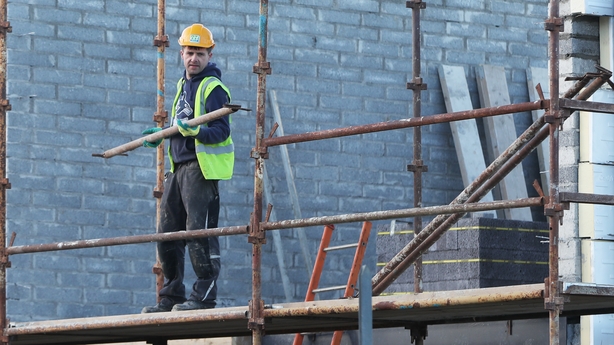New figures from the Central Statistics Office show that the number of people employed in the third quarter of the year rose by 3%, or 66,700, to 2,273,200 - a new record high.
Employment levels have now grown for 25 consecutive quarters.
When adjusted for seasonal factors, employment increased by 0.5% or 10,700 in the third quarter of this year from the second quarter.
The CSO noted that employment increased in 10 of the 14 economic sectors over the year, with the biggest rate of growth seen in the construction sector - up 13.9% - and administration and support service activities, which rose by 13.5%.
The annual increase in the numbers at work in the third quarter was driven by a jump of 44,200 in full-time employment and an increase of 22,500 in those employed on a part-time basis.
The CSO's Labour Force Survey - the official source of data for employment and unemployment - also showed that the seasonally adjusted number of people who were unemployed fell by 2,900 to 136,100 in the three month period.

Today's Labour Force Survey figures also show that the seasonally adjusted unemployment rate stood at 5.7% in the third quarter of this year, down from 5.8% in the previous quarter.
But the CSO today revised upwards the provisional October unemployment rate to 5.5% from its initial reading of 5.3% - a 10 year low.
The seasonally adjusted September figure was also revised up to 5.6% from 5.4%.
Meanwhile long term unemployment - which refers to people who are unemployed for a year or more - accounted for 34.9% of total unemployment in the third quarter of 2018.
Today's CSO figures also show that the total number of people in the labour force stood at 2,417,000, up 2% or 46,900 compared to the same time last year.
The number of people classified as not in the labour force stood at 1,443,200, an increase of 1% or 14,500 from a year earlier.
Today's release also reveals that the number of employees in third quarter of the year was 1,942,700, up 4% over the year, while the number of self-employed persons decreased by 2%.

It also shows that the participation rate stood at 62.6% in the third quarter, compared with a pre-recession peak of 66.7%.
Greater participation should slow down the fall in the jobless rate, commented Merrion economist Alan McQuaid.
The economist noted that there was an average net jobs rise of 61,900 in 2017.
He said a net jobs gain of 66,000 is now forecast for this year.
"The average jobless rate is now projected at 5.7% in 2018, down from 6.7% in 2017. A further fall, to 5%, is envisaged for 2019, with a net increase in employment of around 50,000," Alan McQuaid added.
Goodbody economist Dermot O'Leary noted that while employment growth among Irish nationals was running at a healthy 2.2% year on year in the three months from July to September, employment among non-Irish nationals grew by 7.7% year on year.
Non-Irish nationals now make up a record 16.2% of total employment in Ireland.
"While there is some scope for increased labour force participation, particularly for females, migration will play a vitally important role in the coming years in easing labour market pressures," Mr O'Leary said.

